
Perennial Forbs Around Las Vegas, Vegetation Around Las Vegas
 Upright; large basal leaves; to 6-ft tall; dense flowering spike |
General: Common Mullein (Verbascum thapsus), pronounced Mul-in, is an invasive biennial forb. It is upright with large basal leaves and normally produces one tall, dense flowering spike to about 6-feet tall (flowering spikes sometimes fork into two or more). The leaves are long and broad, light gray-green, and densely covered with woolly hairs. The flowers are yellow with 5 petals. Common Mullein, native to Europe, northern Africa, and Asia, is an invasive weed in our area. Around Las Vegas, this species is becoming fairly common along roadways up on Mt. Charleston, and some can be found in Cabin Canyon in Gold Butte National Monument. We usually leave mountain wildflowers alone, but let's all work to make sure this plant sets few seeds and stays uncommon. Family: Figwort (Scrophulariaceae). |
 Leaves gray-green, densely covered with woolly hairs |
Other Names: big taper, candle-wick, charmin-of-the-woods. Plant Form: Upright, large-leaved forb with a tall flowering stalk. Height: To about 6 feet. Stems: Upright, unbranched. Leaves: Leaves gray-green, densely covered with woolly, stellate hairs. Different lower and upper leaves. Lower leaves to about 10 inches, oblong, lobed, with petiole. Upper leaves lanceolate, to about 5 inches, not lobed, sessile, and with leaf base extending down the stem as a wing for a short distance. Flowers: Sessile on stalk. Radial, deeply 5-lobed. Upper 3 lobes shorter than lower 2 lobes. Upper three stamen stalks covered with hairs; lower two without hairs. Seeds: Produced inside 2-chambered, densely woolly capsule; seeds brown, resembling a tiny ear of corn. |
 Dense, upright flowering stalk, flowers yellow with 5 petals |
Habitat: Roadsides and disturbed, open sites in the mountains. Elevation: To about 7,000 feet. Distribution: Native to Eurasia, introduced weed throughout North America. Comments: Reproduces by seed. Not very susceptible to herbicides due to the dense hairs on the leaves, but digging up the root crown prevents flowering. Seeds can linger in the soil for 35 years, perhaps even 100 years. Other than crowding out native species, this plant is not terribly problematic in natural ecosystems, and it is not terribly problematic in agricultural systems. For More Information: DiTomaso, J.M., and E.A. Healy. 2007. Weeds of California and other Western States. University of California Agricultural and Natural Resources Publication 3488. 2 Vol. ISBN 978-1-879906-69-3. |
 |
 |
 |
 |
 |
 |
 Growing along Mary-Jane Falls Trail on Mt. Charleston |
 Seedling: the best time to dig them up |
 Seedling: the best time to dig them up |
 Seedling: the best time to dig them up |
 |
 |
 Flowering stalk starting to bolt |
 Flowering stalk starting to bolt |
 Flowering stalk |
 Flowering stalk |
 Tip of flowering stalk |
 Ripe flower buds |
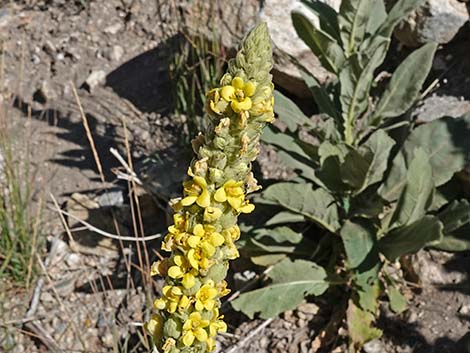 Common Mullein flowers on flower stalk |
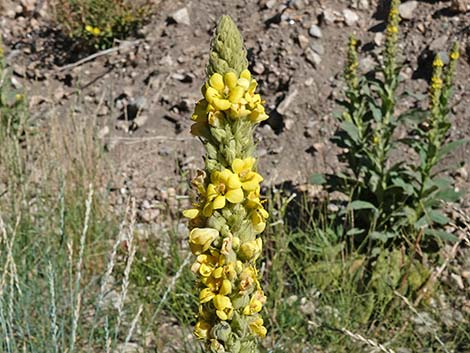 Common Mullein flowers on flower stalk |
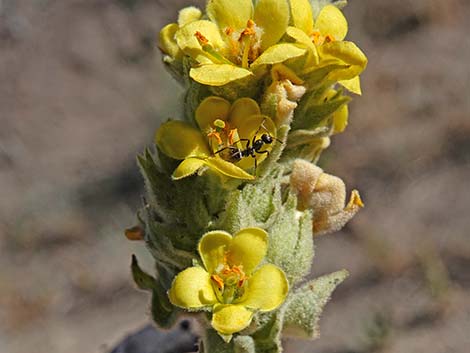 Common Mullein flowers on flower stalk |
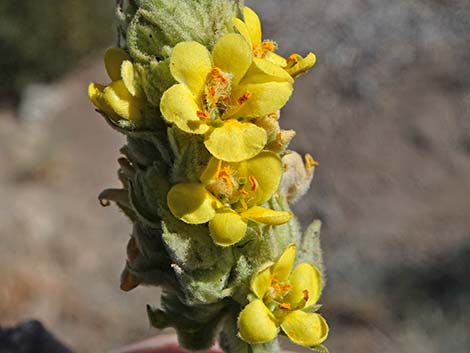 Common Mullein flowers on flower stalk |
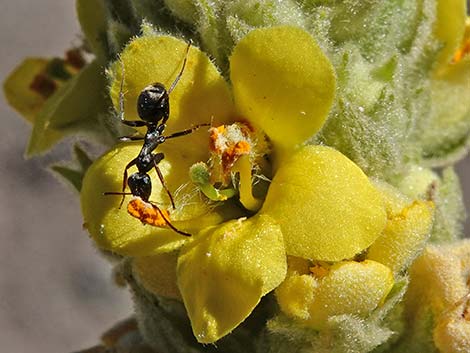 Common Mullein flower and an ant |
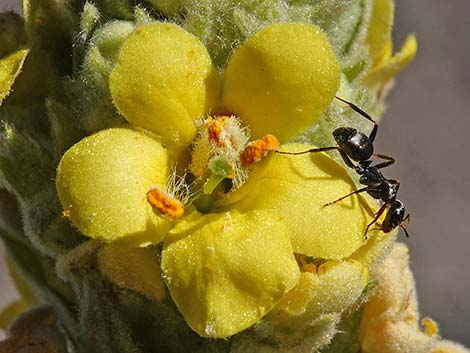 Common Mullein flower and an ant |
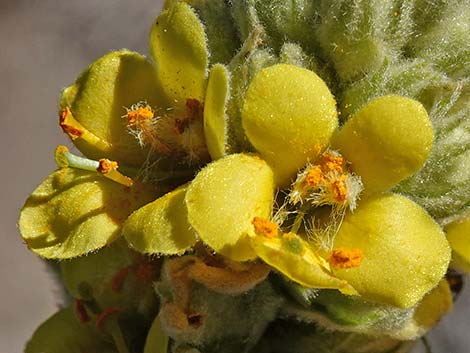 |
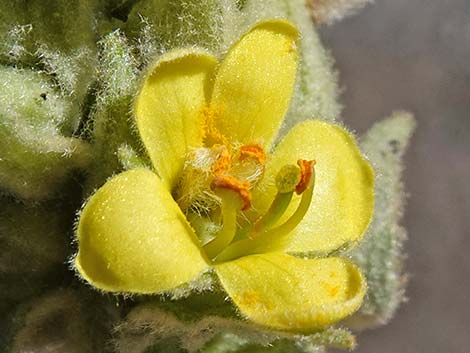 |
 |
 |
 Upper three stamen stalks covered with hairs; lower two without hairs |
 Upper three stamen stalks covered with hairs; lower two without hairs |
 Year-old flowering stalk gone to seed |
 Year-old flowering stalk gone to seed |
 Old seed capsules gone to seed |
 Old seed capsules gone to seed |
 Seeds and chaff |
 Seeds and chaff |
 Seeds (look like corn cobs) and chaff |
 Seeds (look like corn cobs) and chaff |
Note: All distances, elevations, and other facts are approximate. Names generally follow the USDA database.
![]() ; Last updated 240909
; Last updated 240909
| All Perennial Forbs | Plant Species Index | Glossary | Copyright, Conditions, Disclaimer | Home |